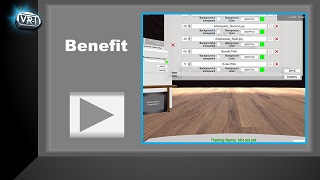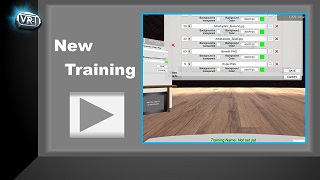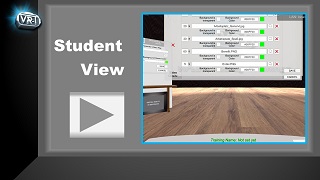The Avatar as Trainer
People prefer to learn from other people (as in personal instruction) than from dead matter.
An avatar is very "human-like" and is sufficient for the emotional connection. It's easy, quick, inexpensive, and fun.
The digital futureCongress 2020 and the jury voted for us as " 3rd most innovativ StartUp" (press release).
Our Pitch for the jury is online: "Within 5 minutes an innovative VR software with avatar".
 |
Sorry for the German language,but you can add automatic translated subtitles. |  |
The "Record Avatar" menu records your speech and all movements. The VR headset and the two controllers are completely sufficient. The big advantage is that you can simply hold your training without complex technology and record everything at the same time.
Every movement with your hands or when you approach the learner's position, it all works like in real life and creates the feeling of being live in the room.
Green screen or lighting -> neither is required.
No “studio technology” is required.
Tipp:
If you run the software in the desktop module on a second computer and "participate" in the training from this computer, you as the trainer see the PC's avatar and can use it as a "point of contact".
-
Read More
Create a new VR-Training
With structured preparation, you and your workouts become more efficient.
Define a rough training structure or process description and which presentation elements should be used.
Prepare the presentation elements and place them in a folder.
Then you have 2 easy options:
1. You use a VR template and enter the file names in Excel
2. You take VR glasses, open the exercise room and modify everything to your liking -
Software-Training Live
There are many completed training courses in various software products (for example, web-based e-learning).
No problem, you can easily continue to use them.
The "Live Screen" function displays a program window in VR and can be operated from there.
The big advantage is that it creates VR-based software that can easily display any other software.
You are completely free which products you want to continue using. -
Read More
Video with Trainer
Even if you can create a training document for reading, but the efficiency is often higher when creating a coach video.
This is not so difficult and you don't need a "video studio equipment".
My training videos I do with the phone. It's easy, fast, inexpensive and fun.
The biggest advantage of a mobile phone is the upright format. That simply corresponds to our image content.Really important is: Light, light and light again
-
Using geometry you can explain problems much faster than with text
To show geometry directly in front of the "headset" of coworkers improves the understanding dramatically.
With VR glasses you can do this without being physically in the same room and this saves travel time.Especially "No - MCAD Users" as electronical designers or repair experts need a really simple tool to show and to work with geometry. What can be more easy than to use the own hands to touch and move product components?
The target is to get a fast overview and an idea how you can improve the design. With this idea you go back to your CAD system and detail the design.
Training on the job with virtual geometry is not 100% same as in prductionline, but your production line does not stop.
So preparation in virtual reality and only a few minutes in real world saves a lot of money.







